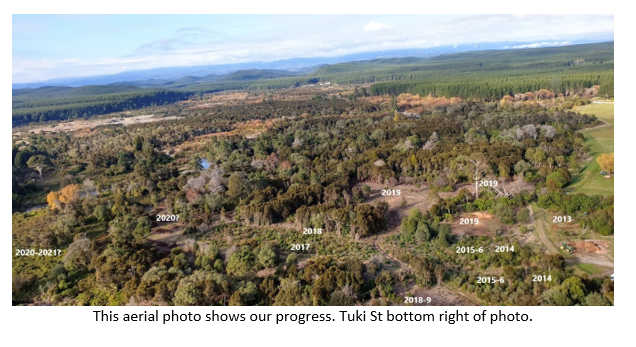Oruatua Restoration
Tuesday, 02 July 2019
In 2007 Ardy and I began trapping introduced predators in the Tauranga-Taupo area, thanks in part to pesky possums eating all of our walnuts! As our possum trapping area expanded through the bush, we began to notice an absence of regenerating native vegetation. We witnessed a clutch of juvenile Piwakawaka fall prey to predators. It was time to take action, this led to our initial self-funded set of Vector snap traps in a collection of homemade boxes.
Our fleet of Timms traps grew rapidly as we realised just how many possums were in “our patch”. I learnt how to skin a possum after deciding that it was a waste to bury them and found a tanner in Napier to turn them into beautiful furs. Mum’s old Bernina sewing machine was bought out of storage and a commercial machined called a Cup Steamer was eventually purchased to sew the skins together. A small cottage industry was born to help fund our conservation efforts. Our cat has had a total possum diet since this began.
For many years we cut and gelled, drilled and poisoned and slashed at climbing plants strangling our native trees. The conservation reserve has some fabulous old Kowhai trees (200 years), Totara, Rimu Kanuka, the occasional Matai but has large patches of open ground with invasive Japanese Honeysuckle, cotoneaster, berberis and Himalayan Honeysuckle. Sadly, we also have willows, hawthorne and wilding pines. We began to notice a difference with our predator work. Many birds we hadn’t seen before such as Kereru were beginning to visit, Popokatea (whiteheads) were now in flocks and holiday makers commenting on how many birds they were seeing. Finally, with predator control in full swing we were seeing native seedlings appearing – with the removal of close to a staggering 2000 possums by this stage.
Hilltop school weed-busters Years 7 and 8 assisted greatly with our momentum thanks to local teacher Collette Taylor. They came down by the bus load from 2013 to 2017 and worked hard on weed infested patches of land behind Heuheu Parade and off Oruatua Avenue. Some large patches of weeds were cleared and planted in natives supplied by the school. The school now has its own projects closer to home.
In October 2014 things changed on a scale we could only dream of. Bryan Lawrance, our local hay contractor, very generously offered to clear a ‘patch’ for us to restore. He had two machines, one to claw all the honeysuckle from the ground and pile it into windows and another to harrow the ground in preparation for planting, Dave Lumley from DOC came to inspect our site and commented “it’s a bit big!” Not at all nervously, I replied “Don’t worry Dave, we’ll look after it!”. So, we had a big patch of cleared land and no trees and no funding – enter Ian and Frances Jenkins who kindly gave us around 300 beautiful home-grown native trees (a generous act that they continue, in greater numbers each year). We managed to score a few from Project Tongariro and some home-grown trees filled the gaps. A drought made the task even more challenging and a bit of borrowed water from the locals was enough to save the day!
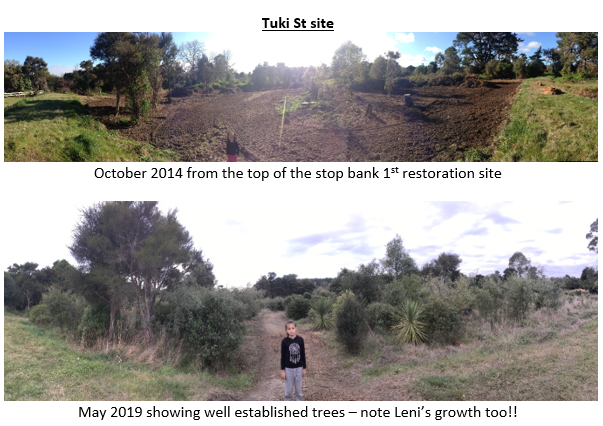
Meanwhile behind the scenes, Bryan has our weedy patch in mind and is building a rotary slasher for the task. Just something you do in your spare time! This rotary slasher is a beast that took no prisoners. He certainly raised the bar on how much land we could prepare and the quality of the preparation. All of this work by Bryan and his machines were free – because he is a good guy and passionate about the land. We are exceptionally lucky.
In 2017 we received funding of $5,000 from the Waikato Regional Council’s (WRC) SCCIF (smalls scale community initiative fund) round, so we had money for trees and a plan. Our next big plot of land was a large well-defined patch of almost 100% blackberry and honeysuckle. DOC kindly did the spray preparation, but the patch of weeds was so large the spray hoses wouldn’t reach. Downers were mowing the stop bank and were happy to detour and cut more access for spraying (koha of a few beers and pumpkins helped).
The WRC funded plants were planted in September 2017, with the trees being sourced from the Tongariro prison, using locally sourced seeds. All the plants have grown beyond our wildest dreams, thanks to the hot wet summer that followed.
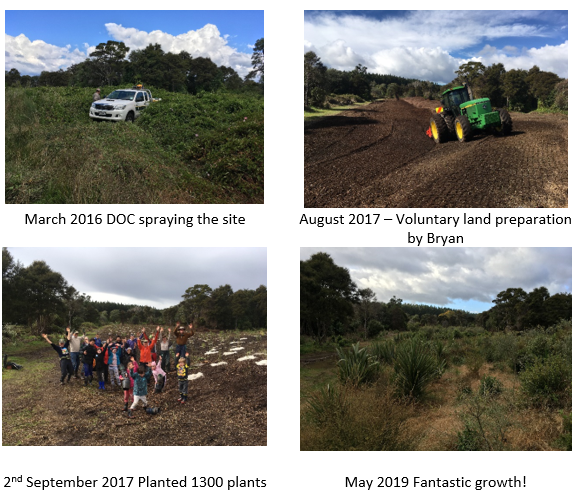
Tania Wells, from DOC arranged for Community Service (old PD) workers to come and help us. They did some great work clearing under existing natives for our next planting site enabling us better access to spray. They moved loads of mulch and made some great toasted sandwiches.
Early 2018, enter Nick Singers with an offer to help on an even grander scale. We had just secured funding from WCEET. So, it was look out weeds here we come.
The patch of land we were preparing was well in excess of the size that our WCEET funding would plant so the opportunity to source more trees was very exciting. I had Dave Lumley visit to inspect our new large site and asked if it was too big “Nah, you’ll be right” was his reply this time! Thanks Dave, for trusting us to take care of the land. Jim Mainopoto, Mike and Te Kanawa Pitiroi local Ngāti Te Rangiita land owners have visited the site on several occasions and have given us their blessing to restore the land.
Our application in October 2018 to Te Uru Rākau was approved in February 2019 for 3400 trees, jute mats, fertiliser tabs, advertising and a BBQ lunch! A generous $18,000 of funding.
Sadly, the prison could not produce an extra 3400 trees in 4 months. We were lucky to have tentatively booked ahead and ultimately received good quality plants from Treeline in Rotorua.
In June 2018 Bryan drove his tractor through the weedy mess to create access for weed spraying (see drone photo below). September 2018, Nick and I used a 500-litre sprayer to knock back weeds. Follow up sprays were made in February and April with help from Sarah and Ardy to ensure a good knock down of invasive weeds prior to planting.
Thanks to WRC for putting Nick and myself through a Growsafe course to enable us to use spray chemicals and to DOC for Ardy’s Growsafe course.
Warrick Simmonds, Willie Tulloch and friends helped immensely by felling 3 massive old man pine trees and removing all the fire wood. One tree alone took 3 months to remove from the site. Thanks guys, as you made our project much easier and gave us access to more land for planing. Again, Bryan came to the fore by mulching all the leftover wood into the soil.
Our first planting for 2019 was to plant 700 trees from the prison nursery, as part of our WCEET funding. This was done by a group of 13 Rotary volunteers from Lower Hutt (with a bunch of loyal locals). They also came for a planting weekend in 2018 and hope to make an annual trip to help us with our restoration work.
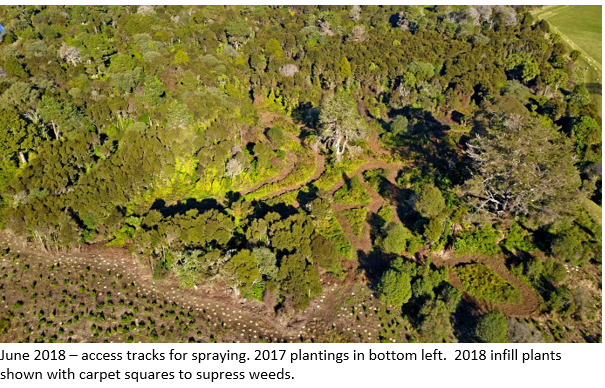
Our Te Uru Rākau funded planting day was 25th May with over 3000 trees being planted by around 65 locals, an amazing turnout for our small community. Heather from MPI joined us for the day and thoroughly enjoyed herself. Not only were the trees planted, but many were mulched and staked, a top effort by all involved. We have a little more tractor work needed on some dead blackberry and the remainder will be planted soon.
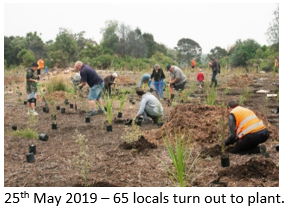
Once the planting has been done the work begins in earnest keeping invasive weeds in check, a sentence for the next 3-4 years at each patch. Fortunately, we are lucky to have had repeat visits from groups wishing to volunteer their time. The groups who have volunteered to help us include St Peters College from Hamilton, Little Brown Kiwi international students, the Navy, Air Force and the Army. I suspect we are at ‘weeding’ capacity now and will need contractor help for ongoing maintenance of any new planting area.
We must not forget to thank the contractors who drop mulch for us an the wonderful collection of locals, family and friends who heed our ‘help’ emails and turn up cheerfully to pull weeds, plant trees, stake, mulch or do any other jobs we need them for.
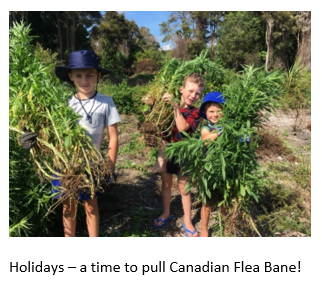
Finally, a massive thanks to Bryan Lawrence, without whom we would still be slashing honeysuckle from the trees.
